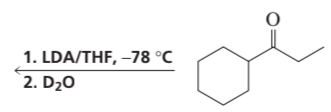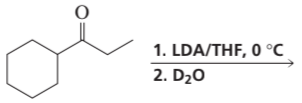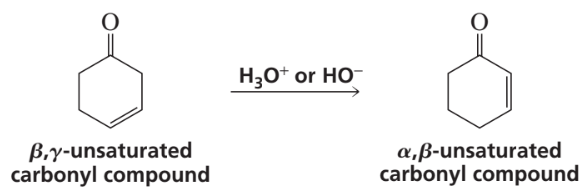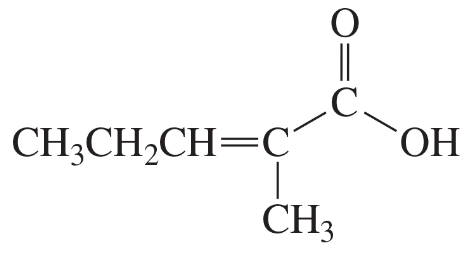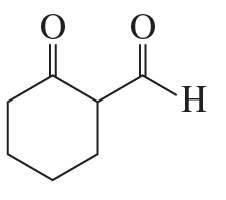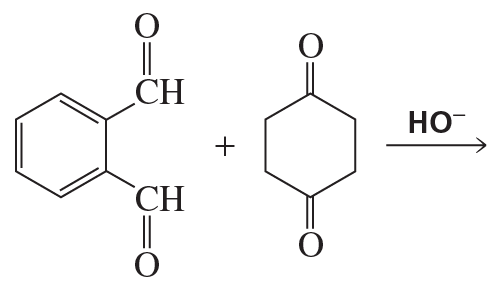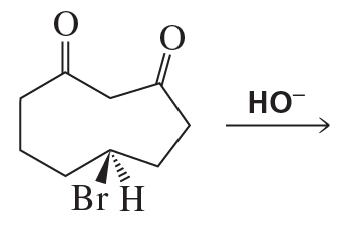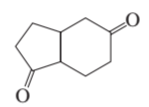 Back
BackProblem 51
The 1H NMR chemical shifts of nitromethane, dinitromethane, and trinitromethane are at δ6.10, δ4.33, and δ7.52. Match each chemical shift with the compound. Explain how chemical shift correlates with pKa.
Problem 52
Which of the following compounds decarboxylates when heated?
Problem 53d
Draw the products of the following reactions:
d. diethyl 1,2-benzenedicarboxylate + sodium ethoxide: (1) slow addition of ethyl acetate; (2) HCl
Problem 55a
Draw the products of the following reactions:
a.
Problem 55b
Draw the products of the following reactions:
b.
Problem 57
An aldol addition can be catalyzed by acids as well as by bases. Propose a mechanism for the acid-catalyzed aldol addition of propanal.
Problem 58
In the presence of excess base and excess halogen, a methyl ketone is converted to a carboxylate ion. The reaction is known as the haloform reaction because one of the products is haloform (chloroform, bromoform, or iodoform). Before spectroscopy became a routine analytical tool, the haloform reaction served as a test for methyl ketones: the formation of iodoform, a bright yellow compound, signaled that a methyl ketone was present. Why do only methyl ketones form a haloform?
Problem 59a,b,c
Identify A–C. (Hint: A shows three singlets in its 1H NMR spectrum with integral ratios 3 : 2 : 3 and gives a positive iodoform test; see Problem 58.)
Problem 60a
Using cyclopentanone as the reactant, show the product of a. acid-catalyzed keto–enol interconversion.
Problem 60a,b
Using cyclopentanone as the reactant, show the product of
b. an aldol addition.
c. an aldol condensation.
Problem 61
Show how 4-methyl-3-hexanol can be synthesized from 3-pentanone.
Problem 62
Show how the following compound can be synthesized from the given starting material. (Hint: Start with an acetoacetic ester.)
Problem 64b
A β-ɣ-unsaturated carbonyl compound rearranges to a more stable conjugated ⍺,β-unsaturated compound in the presence of either acid or base. b. Propose a mechanism for the acid-catalyzed rearrangement.
Problem 65a
There are other condensation reactions similar to the aldol and Claisen condensations:
a. The Perkin condensation is the condensation of an aromatic aldehyde and acetic anhydride. Draw the product obtained from the following Perkin condensation:
Problem 65b
There are other condensation reactions similar to the aldol and Claisen condensations:
b. What compound is formed if water is added to the product of a Perkin condensation?
Problem 65c
There are other condensation reactions similar to the aldol and Claisen condensations:
c. The Knoevenagel condensation is the condensation of an aldehyde or a ketone that has no a-hydrogens and a compound such as diethyl malonate that has an a-carbon flanked by two electron-withdrawing groups. Draw the product obtained from the following Knoevenagel condensation:
Problem 65d
What product is obtained when the product of a Knoevenagel condensation is heated in an aqueous acidic solution?
Problem 66b
Indicate how each of the following compounds can be synthesized from the given starting material and any other necessary reagents:
b.
Problem 66c
Indicate how each of the following compounds can be synthesized from the given starting material and any other necessary reagents:
c.
Problem 67a
The Reformatsky reaction is an addition reaction in which an organozinc reagent is used instead of a Grignard reagent to add to the carbonyl group of an aldehyde or a ketone. Because the organozinc reagent is less reactive than a Grignard reagent, a nucleophilic addition to the ester group does not occur. The organozinc reagent is prepared by treating an α-bromo ester with zinc.
Describe how each of the following compounds can be prepared, using a Reformatsky reaction:
a.
Problem 67c
The Reformatsky reaction is an addition reaction in which an organozinc reagent is used instead of a Grignard reagent to add to the carbonyl group of an aldehyde or a ketone. Because the organozinc reagent is less reactive than a Grignard reagent, a nucleophilic addition to the ester group does not occur.
The organozinc reagent is prepared by treating an α-bromo ester with zinc.
Describe how each of the following compounds can be prepared, using a Reformatsky reaction:
c.
Problem 68
The ketone whose 1H NMR spectrum is shown here was obtained as the product of an acetoacetic ester synthesis. What alkyl halide was used in the synthesis?
<IMAGE>
Problem 69d
Indicate how the following compounds can be synthesized from cyclohexanone and any other necessary reagents:
d.
Problem 70
Compound A with molecular formula C6H10 has two peaks in its 1H NMR spectrum, both of which are singlets (with ratio 9 : 1). Compound A reacts with an acidic aqueous solution containing mercuric sulfate to form compound B, which gives a positive iodoform test (Problem 58) and has an 1H NMR spectrum that shows two singlets (with ratio 3 : 1). Identify A and B.
Problem 71b
b. What carboxylic acid is formed when the malonic ester synthesis is carried out with two equivalents of malonic ester, one equivalent of 1,5-dibromopentane, and two equivalents of base?
Problem 72a
Draw the products of the following reactions:
a.
Problem 72b
Draw the products of the following reactions:
b.
Problem 72c
Draw the products of the following reactions:
c.
Problem 72d
Draw the products of the following reactions:
d.
Problem 73
Show how the following compound can be prepared from starting materials that have no more than five carbons:


